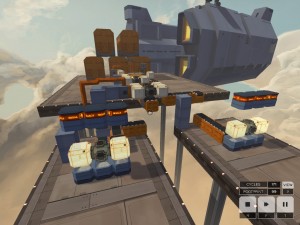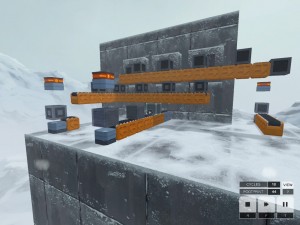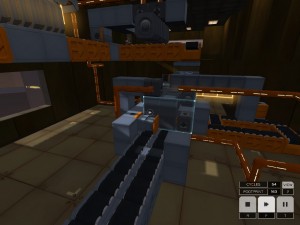Infinifactory is the latest game from Zachtronics whose previous puzzle game Spacechem became one of the most praised and cursed at puzzle titles of 2011 thanks to its challenging gameplay and open-ended design. With Infinifactory, Zach returns to the genre in 3D to give gamers another good reason to challenge their critical thinking abilities.
(Infinifactory may be in early access but as we discussed during our interview, the game is finished in terms of release content and there will be about 3 to 6 months of additional content that Zach and his team will work on at the time of this post. Screenshots and impressions may not match the current build of the game. To view the progress of Infinifactory, you can check out the Infinifactory road map on Reddit)
A Cog in the Machine:
The story of Infinifactory is that one night while driving home you are abducted by aliens who want to use you for their construction efforts. It turns out these aliens need people to help build their manufacturing assembly lines and you are their latest worker/victim.
Just like with Spacechem, Infinifactory looks deceptively simple. The rules are for each puzzle you must move the desired outputs to teleporters located in the level. Items will emerge from specific areas and you need to use the available parts to construct an assembly line to do the job.
At the start your only challenge will be moving single block items to their goals but the game will quickly add new challenges and parts to use. The first being the ability to weld items together to create joint items that can be moved which introduces multi item shapes that need to be transported. The game features a linear campaign broken into planets which will introduce new parts and then challenge you to complete the section to move onto the next planet and so on.

Infinifactory’s progression is less strict compared to Spacechem and you can make progress without having to beat every puzzle.
What’s interesting about Infinifactory is that you keep any new parts and can return to previous puzzles with them to create better optimize solutions.
Just like in Spacechem your results are tracked and compared to your friends via histograms with global scores I believe coming in a future update. The 3D aspect of Infinifactory adds a new wrinkle to the proceedings and further requires you to bend your thinking when it comes to the puzzles.
Around the World Thinking:
Building these assembly lines in a 3D space requires a different thought process compared to Spacechem which was more about logic based pseudo programming. Items don’t move on their own and require either parts like conveyor belts or other items to push them in order to get them going. Whenever an item either turns or falls will slow down the movement of said item which is important when it comes to synchronizing assembly lines.
As long as parts are connected to a solid structure, you can set up assembly lines above and below each other in order to move items to where they are needed. This also factors into the scoring for each puzzle. You are scored based on how many cycles your solution took and your footprint which is the big factor of the 3D space. How footprints are tracked is that for every part that can be viewed from the sky counts as one foot print. However if you have parts lined up parallel above or below another chain, then only one line of parts will be counted.
Just like in Spacechem, puzzles are built to have a variety of possible solutions and even though the game has only just been released, it seems like there are quite a lot of different solutions for puzzles based on the histograms and it will be interesting to see what advanced players will do with the later unlocked parts on the earlier puzzles.
The genius part of this setup is that the two tracked metrics are dynamically opposed to each other which makes figuring out the most optimize solution difficult. To cut down on time you need to keep items moving quickly which means you’re going to need a lot of parts to help speed things up. However every part that you add also increases your footprint unless you really exploit the 3D space.
What’s even better is that besides the continued work from Zachtronics, Infinifactory features Steam Workshop integration which will surely provide a lot of head scratching moments in the future. Speaking of head scratching moments, if you remember my piece on Spacechem, then you know that I had trouble with the difficulty of the game and couldn’t finished it. But despite the greater complexities of 3D adding to the learning curve, Infinifactory does have a leg up compared to Spacechem in terms of teaching the player.
Construction School:
Part of Spacechem’s charm and difficulty was that the game challenged you to understand the abstracted thinking that goes into programming. For people who already understood programming either being self taught or through school, they were able to apply that knowledge to Spacechem’s non linear puzzles. However, for people who didn’t have that background, the game didn’t really teach players how to make use of the tools available and the abstracted nature made it really hard to grow your understanding.
But Infinifactory is different because you’re not dealing in abstraction but the hard concepts of automation and movement. For people like me who learn better through visuals and visualizing concepts, Infinifactory is perfect for me as I can process the puzzles a lot easier in my head than in Spacechem. If there is a problem in your assembly line, you are able to view your assembly line in real-time and figure out where the bottlenecks are compared to Spacechem where the abstracted nature made it difficult to figure out what was going wrong.

Multiple outputs require you to split your automation and makes your solutions similar to the programming-like style of Spacechem.
And the game’s progression model of unlocking new parts as opposed to just throwing everything at the player from the start also helps with the learning curve.
While the basic solutions won’t earn you high marks on the histograms, you’re not going to be overloaded with options as you were with the waldo commands from Spacechem.
Even with that said, Infinifactory isn’t simple by any means and you will likely run into a few puzzles that will stump you no matter what and just like with Spacechem you are left to your own devices to either figure them out or give up. The only difference is that you don’t need to complete every puzzle to get to the end of the game as each section always gives you more puzzles than you need to progress (outside of the first one.)
Just like with Spacechem, learning the advanced uses of all your parts is left up to the player and this can make the game frustrating. Since parts are introduced over time, it will be up to you to figure out how to combine them and put the pieces together (no pun intended.) The game could also use a more elegant solution regarding setting up blocks to either stick or be separate from each other.
Here’s what I mean: Let’s say you want to set up a wall of welder blocks to be pushed into position and then pushed back to where they were. If you set up the welder blocks next to pushers, the game will automatically assume that those parts should be stuck together and therefore the pusher will not activate. As it stands at the time of this post, the only way to get this to work is to build the wall of welders one row higher than what you want, then delete the bottom row so that when you start the machine the remaining welder blocks will fall in front of the pushers and will be push-able.
It’s the only design element in Infinifactory that I would call clumsy as most players won’t even assume that you can do something like this given how the rules and controls are explained to you.
Spacey Automation:
Infinifactory continues Zachtronics’ M.O of simple looking titles with a lot of depth hidden under the surface. In terms of technical problems, I only have a few nitpicks with the controls are a little clunky compared to Spacechem.
The reason is that you are essentially moving around in a 3D space as opposed to the isometric view from Spacechem. And this can make it hard to sometimes get the right depth of field needed.
Also, it can be confusing sometimes when trying to gauge where your pointer is in the air in relation to the ground which is another depth of field issue. And there should probably be more hot keys as you’ll quickly run out of room on the hotkey bar after a few worlds.
For puzzle fans and those that enjoyed the depth and replayability of Spacechem, Infinifactory will be right up your alley. I can’t wait to see what Rube Goldberg like machines people come up with and I do hope that this turns out to be a huge success for Zachtronics so that they can continue working on it and add every brainstorm that Zach has in mind.




